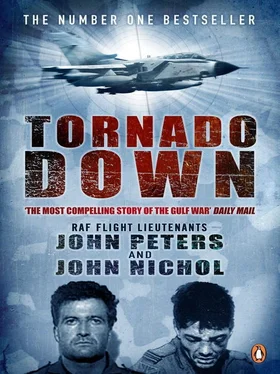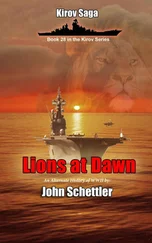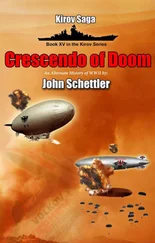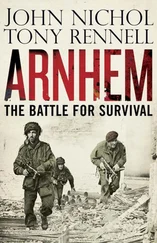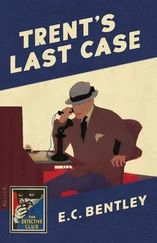‘Nichol,’ he called, ‘you might regret doing that one day!’
He was right.
John Peters: It was a coincidence that John and I had wound up together on XV Squadron. He doesn’t much like me remembering this, but I was the pilot on John Nichol’s first flight. It was in August 1987. As a Staff Instructor at the RAF’s Navigation School at RAF Finningley, in Yorkshire, I was piloting a new batch of trainees on a ‘get-acquainted’ flight. We were chugging around over Lincolnshire in a Dominie, the military version of the HS125 business jet, used by the RAF for training its navigators. John was one of the new boys. They had to deal with the radio, do a few basic navigation exercises, look out the window to see where they were –that kind of thing. For some it was the first time they had ever been airborne. They didn’t have to enthuse on landing, but they nearly all did. Fresh out of Cranwell, the RAF’s Initial Officer Training College, Adrian John Nichol (John to all his friends) was the most enthusiastic.
‘God,’ he said, ‘that was fantastic!’
‘Yes,’ I replied, glancing at him to see if he was joking. The circuit we had just completed was the shortest and most straightforward I regularly flew. I had flown it dozens of times before. But John’s enthusiasm was infectious. Later, we got chatting in the bar. It turned out he had joined the RAF at seventeen, training as a communications technician. After four years at RAF Brize Norton, he had reached the dizzy heights of Corporal. Then he had put in for a commission, and here he was, a few months down the road, Flying Officer Nichol, trainee navigator.
Within two years of our meeting, our roles were reversed. Having been chopped from the Buccaneer Operational Conversion Unit in 1986, I had spent all my time at Finningley righting to get a second chance at flying fast jets. So I was ecstatic when my posting to the Tornado GR1 came through. Somebody up there believed in me. After learning to fly this aircraft, I was posted to XV Tornado Strike/Attack Squadron based at RAF Laarbruch. Here it was my turn to be the new boy, under John Nichol’s wing – one of life’s little ironies. He had been posted there a few months before I had, and was consequently much more up to speed on Tornado operations. On a Tornado squadron, a pilot and navigator are paired up as a crew and will normally fly together. But people come and go for all sorts of reasons, and circumstances often dictate that either your pilot or navigator (your ‘man’) is not available. John and I were paired up occasionally, so for a while he was kept busy showing me the ropes. There were a lot of ropes.
John Nichol: Over the next couple of years after our first meeting, JP and I were not specifically crewed together, but we flew together often. My job, as a navigator, was to operate the Tornado, its systems and its weapons, as well as to navigate, all the while keeping in mind the big air picture. JP’s job was to fly it.
Laarbruch being a front-line operational RAF base, we were invariably training for war against the Warsaw Pact countries. The sign over the door in one of the ground-defence training sections exhorted us that our ‘Job in Time of Peace is to Prepare for War’ – and they meant it. It applied to everybody from the cook in the airmen’s mess to the front-line fighter-bomber pilot. Day-to-day, we flew ground-attack missions over the North German plain, simulating attacks on airfields, bridges, power-stations, factories…
Flying a fast jet like the Tornado is not just about being airborne. A normal sortie would start at 0715 with a meteorological or ‘met’ – weather – brief, then we would plan a mission. Tornados most often attack in units of four, known as ‘four-ships’, or sometimes in units of eight. The targets we flew against in training were chosen for their similarity to the targets we might fly against in a war with the Warsaw Pact. Planning and briefing a mission like this usually ate up about two-and-a-half hours. Then it took about half an hour more to don the remainder of our flying kit, truck out to the aircraft, start it up and get airborne. Frequently, a mission would involve our own fighters making practice attacks on us, just to make the sortie a bit more difficult, and would culminate in our dropping practice bombs on a weapons range somewhere. We would then make our way back to base, perhaps simulating an emergency of some sort on the return trip. Having ‘put the aircraft back to bed’, we would have a chat with the engineers about how that particular Tornado had behaved, and report any significant snags or defects. (The demands of maintenance mean that crews do not normally fly in their ‘own’ Tornado, but take the first one that is available.) Then it was back to the crewroom for the obligatory cup of coffee, before a thorough debriefing to get the most out of the experience. This would include a step-by-step critical examination of the trip, going into every conceivable aspect of the sortie, from the 0715 met brief to the moment we clambered out of the cockpit again to the brand of coffee we drank. For our ninety-minute sortie, we had spent a total of four hours on the ground, preparing and debriefing it.
In the afternoon, we might fly again. If not, there were always plenty of jobs to do in the smooth running of a 6,000-strong, front-line RAF base, quite enough to occupy the time of the fledgling officer. Most of us had secondary duties, which could range from being in charge of the airmen’s accommodation to organising the base Motor Club. Or you might find yourself doing something really menial like running the aircrew coffee-bar. This is widely regarded as the worst job in the world, as it is well known that you can never do it right. If you do not have somebody moaning that you have run out of sugar, you have some health-nut complaining about the lack of skimmed milk. Many a promising career has come to grief over whether to order good old sliced white, or brown bread with birdseed in it! I had to do the job for a year, which I hope was a compliment to my management skills, not a punishment.
John Peters: Although XV was already a front-line squadron, and as such in a high state of operational readiness for war, it was less well prepared for a war with Iraq. For the first few days, the Squadron did not even have a map of the area. The Ground Liaison Officer photocopied one from his Times Atlas , enlarged it and used that as the ‘intelligence board’! The initial briefs, giving us background information about the conflict, were mostly abstracted from editions of the Daily Telegraph .
Despite these little hiccups, everything moved up a couple of gears once we knew we might be going to the Gulf. For a start, we got some decent maps. Because we were unaware of the overall command strategy, the next four months were frustrating: follow-up order and amendment, rumour of war and rumour of rumour of war…‘Yes, you’re going. No, you’re not.’ The whole thing seemed absurd to us. People were annoyed at first, and then amused. At one point, we were told we were taking a brand-new weapon out to the Gulf, the ALARM anti-radiation missile. We spent a week sorting out how to use it in combat; we were to be the first squadron armed with it. It was so new, we dealt directly with British Aerospace, its manufacturers. Then that order was cancelled, and another squadron was earmarked to take over the role.
The Laarbruch engineers began working furiously to prepare the jets, beavering to make the necessary modifications for combat and for desert operations in the few weeks that remained. The most evident of these changes, and the most spectacular, was the salmon-pink paint-job the Tornados were treated to as desert camouflage. They were painted one at a time. When I saw the first one, it gave me a weird feeling in the pit of my stomach: war was dogging our footsteps now, all right. Death in a pink jet! At the same time, everybody wanted to fly the pink jet, because it was different, and therefore somehow ‘special’.
Читать дальше
